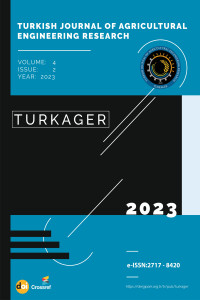Abstract
This study investigates the feasibility of using solar energy for melting recycled older combs and capping wax byproducts to create raw beeswax. The solar-driven beeswax melter is composed of a stainless steel container, a lean-to structure featuring polycarbonate sheet covers, a wooden solar heater, and parallel arrays of PV solar panels. The research contrasts three distinct approaches for melting beeswax: the conventional water bath technique, exclusive reliance on solar energy for melting, and the combination of solar energy and supplementary heat from solar panels. The traditional water bath method's effectiveness and the bulk temperature of the liquified beeswax were gauged. In the case of the solar-powered wax melting setups, the process's efficiency, the melted wax's bulk temperature, and various macroclimatic factors such as sunlight radiation, temperature, and relative humidity were documented. Based on the experimental outcomes, the beeswax melting efficiency was determined to be 73.4% for the traditional water bath method, whereas it escalated to 85.5% and 87.2% for the solar approaches, respectively. Hence, the utilization of solar techniques for beeswax melting is recommended.
References
- Bogdanov S (2009). Beeswax: Production, properties, composition, and control. In Beeswax book. Bee Product Science (pp. 1-17).
- Bogdanov S (2016). Beeswax. In Beeswax book. Bee product science (p. 2-10). Retrieved from https://www.researchgate.net/publication/304012435
- Bradbear, N. (2009). Bees and their role in forest livelihoods: A guide to the services provided by bees and the sustainable harvesting, processing, and marketing of their products; Food and Agriculture Organization of the United Nations: Rome, Italy.
- Duffie JA, and Beckman WA (2013). Solar engineering of thermal processes. New York, N.Y.: John Wiley and Sons.
- FAO (2022). Crops and livestock products: Livestock primary, Beeswax. Retrieved from https://www.fao.org/faostat/en/#data/QCL. (Accessed on 12th July 2022).
- Gemeda M and Kebebe D (2019). Evaluation of the Quality of Beeswax from Different Sources and Rendering Methods. International Journal of Research Studies in Biosciences (IJRSB), 7(6): 20-25.
- Khamdaeng T, Wongsiriamnuay T, Panyoyai N, Narkprasom K and Intagun W (2016). Mechanical properties and melting conditions of beeswax for comb foundation forming. Agricultural Engineering International: CIGR Journal, 18(3): 282-293.
- Khan KA, Ali MH, Obaydullah AKM and Wadud MA (2019). Production of candle using solar thermal technology. Microsystem Technologies, 25: 4505-4515. DOI:10.1007/s00542-019-04390-7.
- Krell R (1996). Value-added products from beekeeping. FAO Agricultural Services Bulletin 124. Food and Agriculture Organization of the United Nations: Rome. ISBN 92-5-103819-8. Retrieved from http://www.fao.org/docrep/w0076e/w0076e00.htm.
- Moharram NA, Tarek A, Gaber M, and Bayoumi S (2022). Brief review on Egypt's renewable energy current status and future vision. Energy Reports, 8: 165-172. DOI:10.1016/j.egyr.2022.06.103.
- Mutsaers M, Blitterswijk HV, Leven LV, Kerkvliet J and Waerdt JV (2005). Bee products properties, processing and marketing. Agromisa Foundation, Wageningen.
- Nuru A (2007). Atlas of Pollen Grains of Major Honeybee Flora of Ethiopia: Sixth National Annual Conference of the Ethiopian Beekeepers Association (EBA), June 2007, Addis Ababa, Ethiopia.
- Sin EHK, Marriott R, Hunt AJ and Clark JH (2014). Identification, quantification, and Chrastil modelling of wheat straw wax extraction using supercritical carbon dioxide. Comptes Rendus Chimie, 17(3): 293-300. DOI: 01016/j.crci.2013.12.001.
- Sofekun GO, Evoy E, Lesage KL, Chou N and Marriott RA (2018). The rheology of liquid elemental sulfur across the λ-transition. Journal of Rheology, 62(2): 469-476. DOI:10.1122/1.5001523.
Abstract
References
- Bogdanov S (2009). Beeswax: Production, properties, composition, and control. In Beeswax book. Bee Product Science (pp. 1-17).
- Bogdanov S (2016). Beeswax. In Beeswax book. Bee product science (p. 2-10). Retrieved from https://www.researchgate.net/publication/304012435
- Bradbear, N. (2009). Bees and their role in forest livelihoods: A guide to the services provided by bees and the sustainable harvesting, processing, and marketing of their products; Food and Agriculture Organization of the United Nations: Rome, Italy.
- Duffie JA, and Beckman WA (2013). Solar engineering of thermal processes. New York, N.Y.: John Wiley and Sons.
- FAO (2022). Crops and livestock products: Livestock primary, Beeswax. Retrieved from https://www.fao.org/faostat/en/#data/QCL. (Accessed on 12th July 2022).
- Gemeda M and Kebebe D (2019). Evaluation of the Quality of Beeswax from Different Sources and Rendering Methods. International Journal of Research Studies in Biosciences (IJRSB), 7(6): 20-25.
- Khamdaeng T, Wongsiriamnuay T, Panyoyai N, Narkprasom K and Intagun W (2016). Mechanical properties and melting conditions of beeswax for comb foundation forming. Agricultural Engineering International: CIGR Journal, 18(3): 282-293.
- Khan KA, Ali MH, Obaydullah AKM and Wadud MA (2019). Production of candle using solar thermal technology. Microsystem Technologies, 25: 4505-4515. DOI:10.1007/s00542-019-04390-7.
- Krell R (1996). Value-added products from beekeeping. FAO Agricultural Services Bulletin 124. Food and Agriculture Organization of the United Nations: Rome. ISBN 92-5-103819-8. Retrieved from http://www.fao.org/docrep/w0076e/w0076e00.htm.
- Moharram NA, Tarek A, Gaber M, and Bayoumi S (2022). Brief review on Egypt's renewable energy current status and future vision. Energy Reports, 8: 165-172. DOI:10.1016/j.egyr.2022.06.103.
- Mutsaers M, Blitterswijk HV, Leven LV, Kerkvliet J and Waerdt JV (2005). Bee products properties, processing and marketing. Agromisa Foundation, Wageningen.
- Nuru A (2007). Atlas of Pollen Grains of Major Honeybee Flora of Ethiopia: Sixth National Annual Conference of the Ethiopian Beekeepers Association (EBA), June 2007, Addis Ababa, Ethiopia.
- Sin EHK, Marriott R, Hunt AJ and Clark JH (2014). Identification, quantification, and Chrastil modelling of wheat straw wax extraction using supercritical carbon dioxide. Comptes Rendus Chimie, 17(3): 293-300. DOI: 01016/j.crci.2013.12.001.
- Sofekun GO, Evoy E, Lesage KL, Chou N and Marriott RA (2018). The rheology of liquid elemental sulfur across the λ-transition. Journal of Rheology, 62(2): 469-476. DOI:10.1122/1.5001523.
Details
| Primary Language | English |
|---|---|
| Subjects | Agricultural Energy Systems |
| Journal Section | Research Articles |
| Authors | |
| Early Pub Date | December 25, 2023 |
| Publication Date | December 31, 2023 |
| Submission Date | August 15, 2023 |
| Acceptance Date | November 10, 2023 |
| Published in Issue | Year 2023 Volume: 4 Issue: 2 |
International peer double-blind reviewed journal


